
-
Find det rigtige foder til din kat eller hund
Tag denne quiz for at se, hvilket foder der kan være bedst for din firbenede ven.
Find det rigtige foder til din kat eller hund
Tag denne quiz for at se, hvilket foder der kan være bedst for din firbenede ven.
Udvalgte produkter
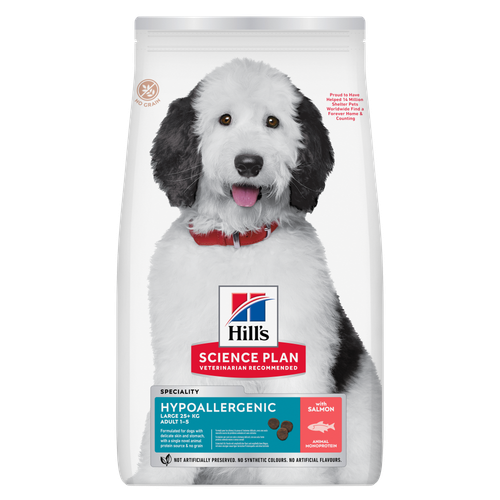 Hypoallergenic Large Breed Adult hundefoder med laks
Hypoallergenic Large Breed Adult hundefoder med laksHILL'S SCIENCE PLAN Hypoallergenic Medium Adult hundefoder med laks er et fuldfoder til voksne store hunderacer på 1-5 år. Det er sammensat til hunde med sart hud og mave, med begrænsede nye proteinkilder af høj kvalitet og uden korn.
køb nu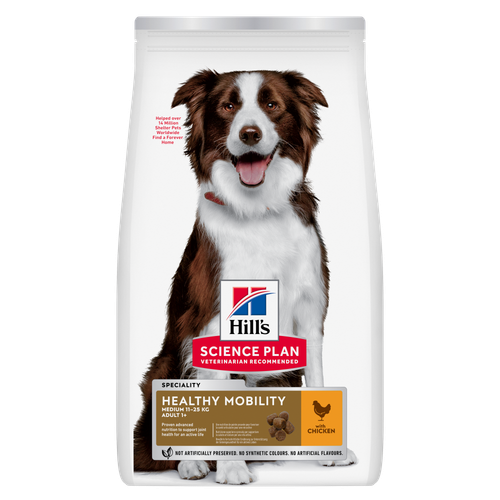 Healthy Mobility Medium Adult hundefoder
Healthy Mobility Medium Adult hundefoderHill's Science Plan Healthy Mobility Medium Breed Adult hundefoder med kylling er avanceret ernæring til at understøtte ledsundheden og forbedre mobiliteten.
køb nu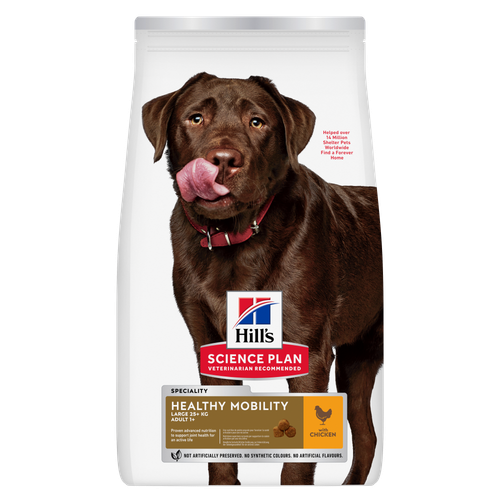 Healthy Mobility Large Breed Adult hundefoder
Healthy Mobility Large Breed Adult hundefoderHill's Science Plan Healthy Mobility Large Breed Adult hundefoder med kylling er avanceret ernæring til at understøtte ledsundheden og forbedre mobiliteten.
køb nuLivsstadie
-
Killing
2 Måneder – 12 Måneder
-
Voksen
1 År - 6 År
-
Ældre voksen
7 År – 11 År
-
Senior
11 År+
Udvalgte produkter
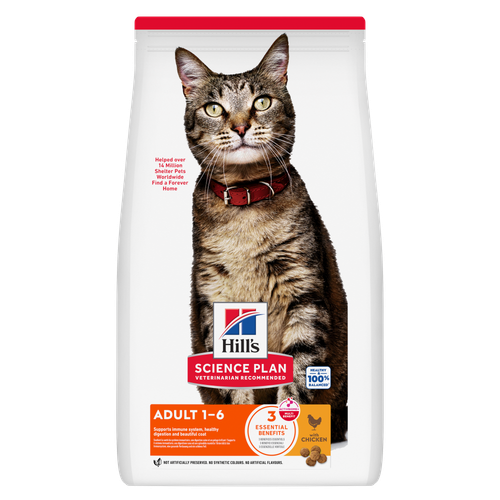 Adult Kattefoder
Adult KattefoderHill's Science Plan Adult kattefoder med kylling er et fuldfoder sammensat med ActivBiome+ Multi-Benefit teknologi.
Dette foder er specielt sammensat til at opfylde kattes energibehov i deres bedste alder.køb nu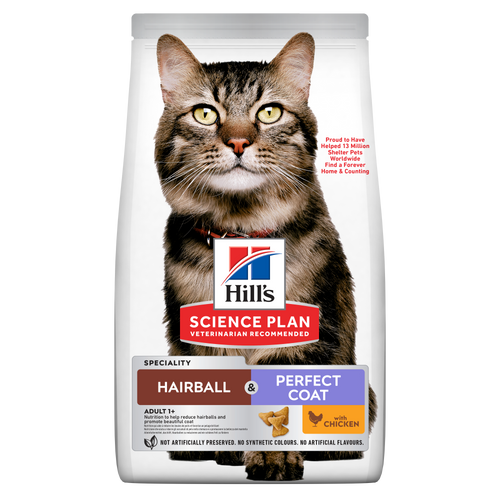 Hairball & Perfect Coat Adult kattefoder
Hairball & Perfect Coat Adult kattefoderHILL'S SCIENCE PLAN Hairball & Perfect Coat Adult kattefoder med kylling er sammensat, så det effektivt hjælper med at undgå dannelse af hårbolde hos voksne katte og samtidig fremmer en smuk pels. Takket være blandingen af vigtige Omega-6 fedtsyrer gavner dette foder kattens hud og pels, så den forbliver sund og skinnende. Vores avancerede fiberteknologi hjælper med at reducere hårbolde ved naturligt at fremme deres passage gennem tarmen. Dette foder er sammensat med protein af høj kvalitet for en perfekt afbalanceret, velsmagende opskrift.
køb nu Hill's Science Plan FELINE ADULT med kalkun, kyllingkøb nu
Hill's Science Plan FELINE ADULT med kalkun, kyllingkøb nu -
Killing
-
Til hundeejere
- Hundetips og artikler
-
Hundesundhedskategori
- Vægthåndtering
- Foder- og miljøfølsomheder
- Urinveje
- Fordøjelse
- Led
- Nyre
-
Hundens livsstadie
- Hvalpeernæring
- Voksenernæring
- Seniornering
Til katteejere
- Kattetips og artikler
-
Kattesundhedskategori
- Vægthåndtering
- Hud- & foderfølsomheder
- Urinveje
- Fordøjelse
- Nyre
-
Kattens livsstadie
- Killingeeræring
- Voksenernæring
- Seniorernæring
Udvalgte artikler
 The Right Diet For Your Pet
The Right Diet For Your PetLearn what to look for in healthy pet food & nutrition, including ingredients, quality of the manufacturer, your pet
læs mere Vis lidt kærlighed med vådfoder: et godt valg for hunde eller katte med helbredsproblemer
Vis lidt kærlighed med vådfoder: et godt valg for hunde eller katte med helbredsproblemerVis lidt kærlighed med vådfoder: et godt valg for hunde eller katte med helbredsproblemer.
læs mere Pet Food Storage Tips
Pet Food Storage TipsWhere you store your cat and dog food can make a big difference in the quality and freshness once it is opened. Here are some common questions and recommendations for optimal storage for all of Hill’s dry and canned cat and dog food.
læs mere -
Find det rigtige foder til dit kæledyr
Find det rigtige foder til dit kæledyr


Itchy ears in dogs are a common reason for trips to the vet. The constant scratching and head shaking can drive you mad, not to mention your dog. Having itchy, sore ears is never pleasant, so it’s important to understand what to look out for and when you need to seek help. In this article, we’ll look at why your dog’s ears may be itchy and what you can do to get you both some very welcome relief.
Common causes of ear irritation in dogs
There are lots of things that can make your dog’s ears feel itchy. Often, dogs will get into a vicious circle of itching and scratching. They can inflict quite a lot of damage if the cause isn’t found and addressed early on. The main causes of itchy ears in dogs are:
Parasites
Foreign objects
Food allergies
Atopic dermatitis
Breed
Infection. Secondary infection due to the other causes of itchy ears can complicate matters further.
CM/SM or chiari-like malformation/syringomyelia
Let’s take a look at these in more depth.
Parasites:
All dogs pick up parasites at various times in their lives. It’s an inevitable part of being a dog and going out and about on fun walks. Fleas are the most common parasites, and they tend to prefer the head, neck and rear end as places to hang out. If your dog is head-shaking or scratching, fleas are the very first thing to rule out.
Dogs can also get ear mites, called Otodectes by vets, and another type of mite called Sarcoptes. Both of these can cause intense irritation in the ear and, in the case of Sarcoptes, also on the flap of the ear and in the axillae, which are like your dog’s armpits.
Ticks can also be a big problem, particularly in warmer climates and environments such as meadows and woodland. Ticks are opportunists and wait for a dog to brush past the undergrowth to climb on. This means the head and ears are commonly where they end up.
Foreign objects:
It’s surprisingly common for foreign objects like grass seeds – or foxtails as they are also known due to their bushy appearance – to get trapped in the ear. Dogs with furry, dangly ears, like spaniels, are the most likely candidates, but it can happen to any dog, particularly if your dog suddenly starts shaking their head or scratching at their ears after a walk. The barbs on grass seeds mean they go in only one direction when they get trapped in fur. As well as causing lots of ear problems, they can also penetrate paws and skin and cause untold problems when they start to migrate.
Food allergy:
Just as with atopy, food allergies in dogs can also cause skin symptoms like itchy ears, as well as gastrointestinal disturbances like diarrhoea. Food allergies are more common in some breeds of dog than others, such as boxers, Labradors and pugs.
Atopic dermatitis (atopy):
Atopy is an allergy to environmental elements like pollen, plants and dust mites. It causes itching in many parts of the body, including the ears. Some breeds like Labradors, golden retrievers, boxers and West Highland White Terriers are more prone than others.
Breed:
As mentioned, some breeds of dog are more prone to atopy and food allergy – and therefore itchy skin and ears – than others, but the shape, size and hairiness of different breeds’ ears also have a big impact. ‘Natural’ dogs tend to have erect or semi-erect ears. They have fine hairs around the entrance to help trap dirt and stop debris getting in, but the ear canals themselves are hair-free, open and well-aerated.
Spaniels and other breeds with very hairy ear flaps are more likely to pick up grass seeds. Anything that alters the environment in the ear canal will predispose them to different bacteria, inflammation and infection. Basset hounds and other dogs with very pendulous ears, shar-peis with ears that are clamped tightly to the head and breeds like poodles that have very hairy ear canals all have poor air flow and are prone to infection. When choosing a dog, always choose one with as natural an ear shape and proportions as you can.
Infection:
Both bacterial and yeast infections can cause painful inflammation and itching in the ears. If your dog has an ear infection, you may notice an unpleasant smell or a discharge coming from one or both ears. These infections are often secondary to the other primary causes but complicate matters and perpetuate the itch/scratch cycle.
Chiari malformation/syringomyelia (CM/SM):
Although this condition is uncommon in dogs in general, it is becoming increasingly common in some breeds, especially the Cavalier King Charles spaniel. It entails a mismatch between the skull size and the brain and may cause painful headaches and other symptoms. Some of these dogs appear to obsessively scratch their ears and neck, but it’s not actually a skin irritation at all; it’s neurological. If you have a King Charles spaniel and your vet can’t find a cause of ear or skin irritation, it may be worth considering if CM/SM is the cause.


Lækre Tips
Hvalpe kan have brug for flere besøg i deres første år til vaccinationer. Voksne hunde har generelt gavn af årlige kontroller, mens seniorhunde eller hunde med særlige behov kan have behov for hyppigere besøg.
How is the cause of itchy ears in dogs diagnosed?
There’s a well-known saying in veterinary and human medicine: ‘Common things are common’. It may sound obvious, but your vet will start by ruling out the most common and obvious things first.
General physical exam. Before even looking at your dog’s ears, your vet may want to do a full physical exam. They will be looking for signs of parasites like fleas and other generalised signs of skin problems such as bald patches and scabs. These can all be pointers to the cause of the itchy ears.
Otoscope exam. An otoscope is an instrument for looking into your dog’s ear canal with a light and a magnifying glass. Your vet will use this to check for obvious things like grass seeds, but also for ear mites, inflammation and infection. Sometimes, dogs are so frantic and uncomfortable that your vet may need to sedate them in order to safely carry out this exam.
Swab and culture. These will be used to identify bacteria or yeast infections.
Skin scrapes. These are performed to look for microscopic parasites like sarcoptic mange.
Allergy investigation. This may involve food trials or blood and skin tests for environmental allergies.
- MRI. This will be far down the list of tests and will be reserved for breeds prone to CM/SM after other causes of itchy ears have been ruled out.
How will my dog’s itchy ears be treated?
As you can imagine, the treatment for your dog’s itchy ears will depend entirely on the cause. Often, once a whopping grass seed has been plucked deftly from your dog’s ear canal, the relief is instant and everyone is happy!
However, other treatments may be needed and can be lengthy. These may include:
Cleaning. Often, dogs with itchy ears get a build up of wax and may have pus in their ears. If your vet gives your dog medicated ear drops, you may need to clean their ears first so that the drops can get to the skin and be effective. Your vet will demonstrate what you need to do and explain how often.
Medications. Anti-inflammatory, antibiotic or antifungal ear drops may be given, or even all three! Your vet may also prescribe oral antibiotics if drops are not going to be enough. Your dog may have an injection of an anti-inflammatory to give relief from the itching and break the scratch cycle.
Diet change. For dogs with food allergies and atopy, diet change can make a huge difference. Therapeutic diets for food allergy sufferers are curative for the vast majority of dogs. There are also diets available that have anti-inflammatory properties and even help restore the skin barrier function in atopic dogs. Your vet will be able to guide you to which diet is best for your individual dog.
Allergy relief. Dietary change, antihistamines or environmental management may be needed depending on what your dog is allergic to.
Parasite treatment. Depending on what parasites your dog has, your vet may prescribe drops, a spot-on treatment or medicated shampoos.
Never poke around in your dog’s ears or put anything in them without the say-so of your vet. You may damage their ears or hearing or exacerbate inflammation and cause more pain.
Can I prevent itchy ears in my dog?
There are some things you can do to try to help prevent ear problems in the first place:
If your dog has very furry ears, you can keep the hair clipped short, especially in the summer months when grass seeds are an issue. Try to get into the habit of checking your dog’s ears and paws after each walk to make sure seeds haven’t hitched a ride in the fur. If you see a seed heading into the ear canal, see your vet to have it removed with the right tools.
If your dog is an avid swimmer, they may have more ear problems because of the moisture. If you can gently dry their ears with some cotton wool after each swim, it may help.
Keep your preventative parasite control up to date.
Summary
If your dog starts showing signs of ear irritation, the best thing to do is see your vet as soon as possible. As we said, the treatment will vary depending on the underlying cause, but it’s best to seek prompt attention, as foreign objects and infections can quickly become quite serious and threaten your dog’s hearing. It’s better to be safe than sorry, and with any of these problems, the sooner you get treatment started, the better.
FAQs
Why is my dog scratching their ears all the time?
There are lots of things that can cause itchy ears in dogs. The most common are parasites, foreign objects like grass seeds, infections and allergies.How can I tell if my dog has an ear infection?
Infected ears are often dirty, inflamed and smelly. If ever you are worried about your dog’s ears, see a vet as soon as you can.Can food allergies cause itchy ears in dogs?
Yes, both food allergies and environmental allergies (atopy) can cause itchy ears in dogs.What’s the best treatment for itchy ears in dogs?
This will depend on the cause. Never try to treat your dog’s itchy ears without seeing your vet. You can easily cause pain and may make things worse.How can I prevent ear problems in my dog?
Keep your dog’s ear fur trimmed short, especially in summer. Dry inside your dog’s ears gently with cotton wool if they go swimming. Keep parasite treatment up to date.
Reviewed by Dr. Hein Meyer, DVM, PhD, Dipl-ECVIM-CA and Dr. Emma Milne BVSc FRCVS.


En af vores medarbejdere har udarbejdet denne artikel til dig
Anbefalede produkter til katte med nyreproblemer
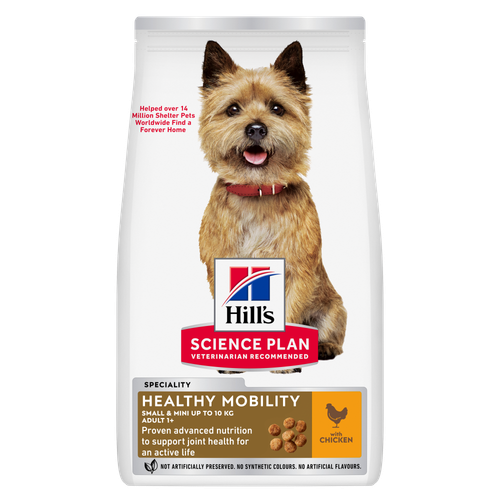
Hill's Science Plan Healthy Mobility Small & Mini Breed Adult hundefoder med kylling er avanceret ernæring, der understøtter leddenes sundhed og forbedrer mobiliteten.

Hill's Science Plan Healthy Mobility Medium Breed Adult hundefoder med kylling er avanceret ernæring til at understøtte ledsundheden og forbedre mobiliteten.

HILL'S SCIENCE PLAN Hypoallergenic Medium Adult hundefoder med laks er et fuldfoder til voksne store hunderacer på 1-5 år. Det er sammensat til hunde med sart hud og mave, med begrænsede nye proteinkilder af høj kvalitet og uden korn.

Hill's Science Plan Healthy Mobility Large Breed Adult hundefoder med kylling er avanceret ernæring til at understøtte ledsundheden og forbedre mobiliteten.
Relaterede artikler

Learn how to stop your dog from begging at the dinner table, and understand how it can help contribute to his health.

Though it may seem like your four-legged friend loves nothing more than to nap on the couch, dogs need regular exercise to stay healthy just like people do.

Just like every other pet owner, vets are responsible for giving their pets the best possible nutrition, exercise and care needed to keep them healthy and happy.

Signs of a healthy dog include healthy skin and a healthy coat. This article provides information on the appearance of a healthy coat, the importance of grooming, brushing, bathing and nutrition in the care of maintaining a healthy dog.
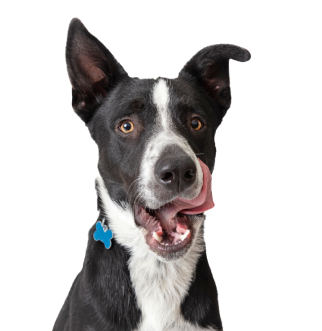
Sæt din hund på diæt uden at den opdager det
Vores kaloriefattige sammensætning hjælper dig med at kontrollere din hunds vægt. Den er fyldt med protein af høj kvalitet til at opbygge slanke muskler og lavet med udvalgte ingredienser for et velsmagende og nærende måltid. Klinisk dokumenterede antioxidanter, vitamin C+E, hjælper med at styrke et sundt immunsystem.
Sæt din hund på diæt uden at den opdager det
Vores kaloriefattige sammensætning hjælper dig med at kontrollere din hunds vægt. Den er fyldt med protein af høj kvalitet til at opbygge slanke muskler og lavet med udvalgte ingredienser for et velsmagende og nærende måltid. Klinisk dokumenterede antioxidanter, vitamin C+E, hjælper med at styrke et sundt immunsystem.

